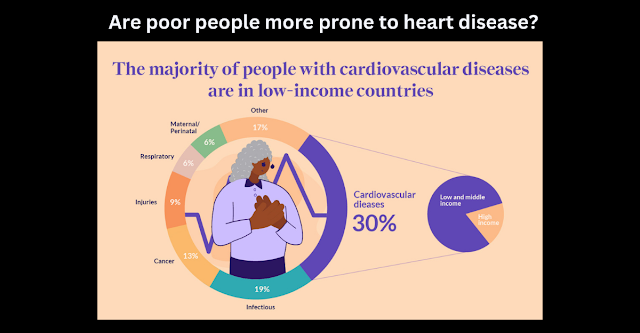Are poor people more prone to heart disease?
Why are poor people more susceptible to heart disease?
The common belief about heart disease and stroke used to be that it mostly
affected the rich. The assumption was that these people probably ate a lot of
meat and fatty foods.
However, in the past few years, reports and studies have emerged about the reasons for the increasing number of people suffering from heart disease and the prevalence of this disease in the poor, the most recent of which was conducted by the British University.
Oxford has revealed the changing trends and continuing challenges in heart
disease over the past 20 years.
Researchers analyzed electronic health records of 22 million people. Of
these, 16.5 million had at least one heart attack between 2000 and 2019. The
average age of these people was 70.5 years, and 48 percent of them were women.
The study found that people living in poor areas were twice as likely to
have heart disease as those living in wealthier areas.
Researchers analyzed electronic health records of 22 million people. Of
these, 16.5 million had at least one heart attack between 2000 and 2019. The
average age of these people was 70.5 years, and 48 percent of them were women.
The study found that people living in poor areas were twice as likely to have
heart disease as those living in wealthier areas.
What is heart disease?
Heart disease, collectively known as cardiovascular disease (CVD), includes
a group of conditions that affect the heart and blood vessels. Some of the most
common types of heart disease are:
Coronary artery disease:
This is caused by a
buildup of plaque in the arteries that supply blood to the heart and can cause
chest pain (angina), shortness of breath, and heart attacks.
Heart attack (myocardial infarction):
This occurs when part of
the heart muscle does not get the blood it needs.
Heart failure:
Also known as heart failure, this occurs when the heart cannot pump enough
blood to meet the body's needs.
Erythema:
resulting symptoms include rapid heartbeat, dizziness, difficulty breathing,
chest pain, and fainting.
Cardiomyopathy:
which makes it difficult for the
heart to pump blood to the rest of the body, and can lead to heart failure.
Heart valve disease:
This is damage to one or more heart
valves, which can disrupt the flow of blood through the heart.
Congenital heart defects:
These are structural problems of the
heart that a person is born with, and they range from simple defects without
symptoms to complex problems with severe life-threatening symptoms.
Aortic disease:
Conditions that affect
the aorta. The aorta is a large artery that carries blood from the heart to the
rest of the body.
Peripheral artery disease:
This is a condition in
which the blood vessels narrow and blood flow to the limbs is reduced. This can
result in leg pain when walking, numbness (loss of feeling), weakness in the
legs, or coldness in the lower leg or foot.
Rheumatic heart disease:
This is damage to the
heart valves and heart muscle due to inflammation and scarring caused by
rheumatic fever. It is caused by the bacteria Streptococcus.
Understanding these types of heart diseases, their symptoms, and their
effects on health can help in early detection, prevention, or treatment of
heart disease.








